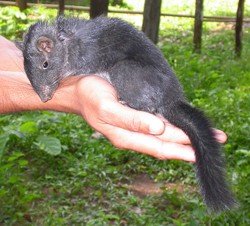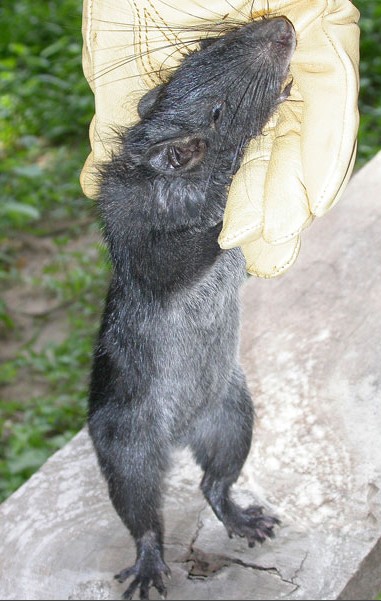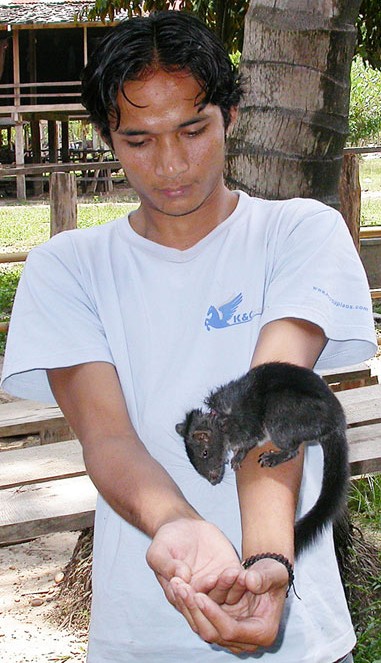Living Fossil Caught on Video
Posted by: Loren Coleman on June 16th, 2006

David Redfield’s journey to Southeast Asia leads to live specimens of the Laotian rock rat
TALLAHASSEE, Fla. — The first images of a live specimen of a small, furry animal once believed to have gone extinct more than 11 million years ago have been captured during a Southeast Asian expedition led by a retired Florida State University researcher.
The remarkable video and photos shot by David Redfield, a professor emeritus of FSU’s science education faculty, and Thai wildlife biologist Uthai Treesucon are being hailed as historic images documenting a true “living fossil,” the Laotian rock rat.

The Laotian rock rat is so called for its only known habitat — limestone outcroppings in Central Laos — and the appearance of the animal’s head and face, which sport long whiskers and beady eyes like those of a rat.
Redfield’s video shows a docile, squirrel-sized animal covered with dark, dense fur and bearing a long tail that’s not as bushy as that of a typical squirrel. Perhaps the most striking observation is how the animal walks — like a duck. Clearly not adapted to climbing trees, the rock rat exhibits a duck-like waddle with its hind feet splayed out at an angle to its body.

An avid but otherwise amateur wildlife observer, Redfield has traveled the world since retiring in 1988 from a career in teaching and research at FSU. A passion for bird watching in the 1990s segued into an interest in seeing some of the world’s rare mammals in their native habitats. When he learned about the discovery of the Laotian rock rat last year — and that no one had seen a live specimen — Redfield set out on a personal quest to accomplish the feat.
“We were extremely fortunate in so many ways to be able to do this,” Redfield said of the discovery. “It’s easily one of the most gratifying experiences of my life, and I hope these pictures will help in some way to prevent the loss of this marvelous animal.”
Known as kha-nyou (pronounced “ga-noo”) in Lao villages near its habitat, the animal was first described scientifically in the April 2005 issue of the journal Systematics and
Biodiversity. Identified as a member of an entirely new family of mammals, the rock rat made news around the world. It gained international attention again on March 10 of this year when scientists published a paper in Science magazine re-identifying the animal as a “living fossil” whose last remaining relatives went extinct 11 million years ago.
Mary Dawson, curator emeritus of vertebrate paleontology at the Carnegie Museum and primary author of the paper published in March in Science, recently reviewed Redfield’s images and confirmed their authenticity.
“This is a truly exciting discovery,” Dawson said. “Dr. Redfield’s sighting of the living animal is the first to be recorded scientifically. These are the first photographic images of the recently discovered ‘living fossil’ Laonastes aenigmamus.”
Dawson led the team of scientists who used fossilized remains collected from sites in Pakistan, India, Thailand, China and Japan to prove that, instead of being completely new to science, the rare animal actually was the last known relative of a long-extinct family of rodents known as Diatomyidae. Dawson’s paper described the rock rat as an example of the “Lazarus effect,” a reference to the Biblical character Lazarus who returned from the dead. Biologists use the term to refer to those rare instances when animals long thought to be extinct turn up alive and well in some remote habitat.
“Dr. Redfield’s discovery and these images are extremely important scientifically, showing as they do an animal (with) such markedly distinctive anatomical and functional attributes,” Dawson said. “These are amazing pictures.”
Redfield used some of his contacts in Southeast Asia — made from numerous bird-watching field trips to the region over the years — to help coordinate his trip to Laos this past May. Using native guides and interpreters, he succeeded in gaining the confidence of local hunters near a Central Laotian village close to the Thai border. After four failed attempts, the hunters finally captured a live rock rat. Redfield and his hosts returned the animal safely to its rocky home after photographing and videotaping it.
Redfield credits Treesucon, a renowned biologist and birder, with coordinating the logistics of the expedition that culminated in the successful capture of the animal on May 17 near the Laotian village of Doy.

Press release, courtesy Florida State University.
About Loren Coleman
Loren Coleman is one of the world’s leading cryptozoologists, some say “the” leading living cryptozoologist. Certainly, he is acknowledged as the current living American researcher and writer who has most popularized cryptozoology in the late 20th and early 21st centuries.
Starting his fieldwork and investigations in 1960, after traveling and trekking extensively in pursuit of cryptozoological mysteries, Coleman began writing to share his experiences in 1969. An honorary member of Ivan T. Sanderson’s Society for the Investigation of the Unexplained in the 1970s, Coleman has been bestowed with similar honorary memberships of the North Idaho College Cryptozoology Club in 1983, and in subsequent years, that of the British Columbia Scientific Cryptozoology Club, CryptoSafari International, and other international organizations. He was also a Life Member and Benefactor of the International Society of Cryptozoology (now-defunct).
Loren Coleman’s daily blog, as a member of the Cryptomundo Team, served as an ongoing avenue of communication for the ever-growing body of cryptozoo news from 2005 through 2013. He returned as an infrequent contributor beginning Halloween week of 2015.
Coleman is the founder in 2003, and current director of the International Cryptozoology Museum in Portland, Maine.










Obviously caught with a noose trap don’t you think. Still congrats!
Now that’s a good lookin’ critter! Great job!
Congrats to Redfield and Treesucon!
Good things do come in small packages. See?
One more hole filled in….probably many more small ones (and maybe a few more really big ones) to go….;-)
Gotta agree with KYChaser about the posible use of a noose trap, what with the big ring of disturbed fur behind its head. Poor thing also seems to have its head stuck in that perpetually downward stare I have when I sleep on my neck wrong and get a kink.
But, that aside, an amazing find and amazing shots. Astounding finds just keep coming out of southeast Asia (which, while exciting, also says something about shrinking habitats and human encroachment).
All other commentary aside though, 11 million years is a LONG time for our little debutante to wait for her cotillion. Lazarus indeed.
This is great news!!! And they returned him to where they caught him that is also nice.
Wow. Nice job on their part, and it’s good to see cryptozoologists being able to actually show off a previously ‘extinct’ species…
I’m probably going to get in trouble here but they look like they would make awesome pets. I want one!
Is that “ga-noo”‘s name Gary?
::Pauses for obscure pop culture reference to take effect::
Poor thing looks like it hurt its neck. =( Awesome discovery though!
well if it was a fake it would not have its bushy tail and long weird nose so i think it is real 😮
i love rats and have 6 of my own
great job and congrats on the discovery!! :O
Perhaps that noose and it’s near-neack-breaking grip are the cause of the duck-like waddle?
indeed… thanks for that interesting lesson and the “good gnews” Mynames (and DWA)